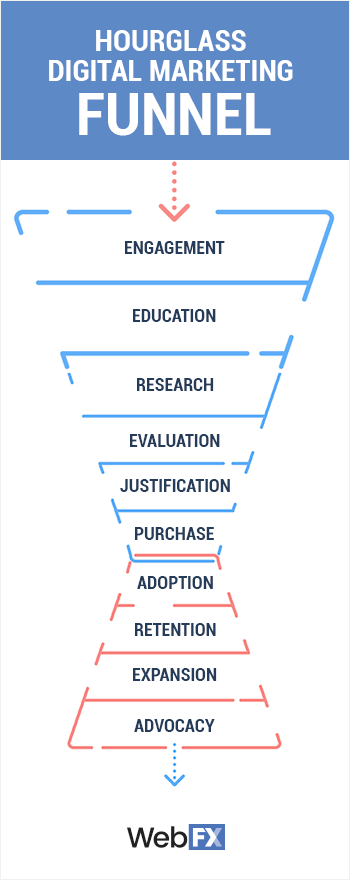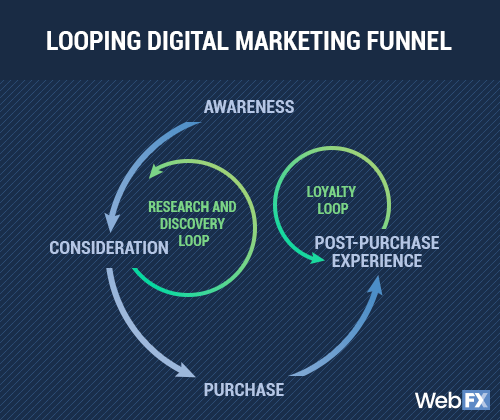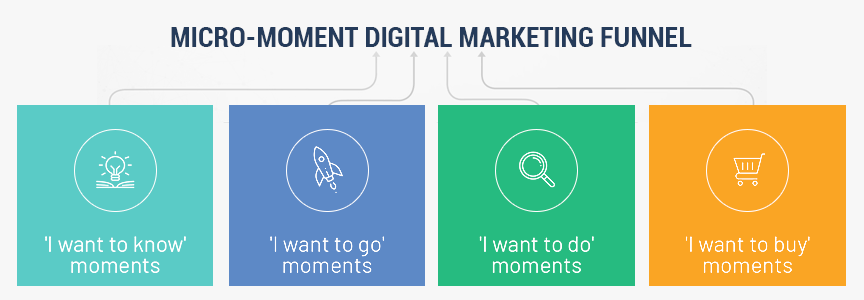
If your business wants to succeed, it’s time to adopt the online marketing funnel of today.
A digital marketing funnel describes the steps that users take to move from being a prospect to a customer. While there are multiple marketing funnels, most include stages focused on awareness, consideration, purchase, and retention. Businesses can use any funnel to guide their marketing efforts.
The new vs. old digital marketing funnel

Whether you’re familiar or unfamiliar with the previous digital marketing funnel, it’s worth reviewing how the two compare. That way, your team can see how you need to adapt your strategy to meet current user behaviors.
For reference, the old marketing funnel (often called the AIDA model) includes these four stages:
- Awareness: A person knows your product or service exists.
- Interest: A person expresses interest in your product or service.
- Desire: A person wants your product or service.
- Action: A person purchases your product or service.
Get a quick comparison of the new versus old Internet marketing funnel:
New Digital Marketing Funnel
- Focuses on a non-linear experience
- Consists of up to 10 steps
- Thinks about the behaviors driving a user
Old Digital Marketing Funnel
- Focuses on a linear experience
- Consists of four steps
- Thinks about universal user behaviors
Overall, the new digital marketing funnel focuses more on each user than the old one. While moving towards a non-linear journey poses more of a challenge to businesses, it allows your company to provide a better experience to your target market.
Why did the digital marketing funnel change?
The rise of technology made changes to the digital marketing funnel inevitable. The number of Internet users is now more than four billion, plus there are more than 2.5 billion smartphone owners. With the ability to search on the go, users can find, research, and buy products anywhere.
They also have an immense amount of information available to them. Consumers can browse articles, read reviews on social media, watch videos on YouTube, and more. All these opportunities have allowed users to create a custom, non-linear shopping experience.
This evolution resulted in the original Internet marketing funnel becoming ineffective. With its structured, linear approach, it failed to consider the various paths that a user can take, which made businesses miss critical opportunities for reaching and converting a consumer.
That’s why the online marketing funnel needed to change.
Why does the digital marketing funnel even matter?
Learning and adopting a digital marketing funnel can help your business in several ways, including:
- Discover the strategies, like content marketing, that will help your audience the most
- Understand the motivations that drive your target audience to research and purchase
- Realize why specific strategies, like downloadable content, only work at certain stages
- Uncover how and when to nurture relationships with leads and current customers
- Build an effective plan for marketing to users at different stages of the funnel
When you take the time to research the marketing funnel, as well as your buyer journey, you can improve your marketing strategy. Instead of guessing what your audience wants, you can use your data to build a data-backed campaign for attracting and nurturing new and existing customers.
Today, the digital marketing funnel captures the non-linear journey of shoppers, from businesses to consumers. As every user takes a different path, there are several versions of the new online marketing funnel.
Here are the three most common forms of the website marketing funnel of 2021.

1. Hourglass digital marketing funnel

This online marketing funnel takes a detailed approach to the customer journey stages. In comparison to previous funnels, the hourglass digital marketing funnel emphasizes the importance of building and maintaining customer relationships. This approach is behind the funnel’s hourglass shape.
The pre-purchase stages of this marketing funnel include:
- Engagement: Building brand awareness
- Education: Identifying a problem
- Research: Discovering a solution
- Evaluation: Determining how a product or service resolves a problem
- Justification: Validating the purchase of a product or service
- Purchase: Buying the product or service
The post-purchase stages of this funnel include:
- Adoption: Using a product or service
- Retention: Ensuring a user’s satisfaction
- Expansion: Upselling a user
- Advocacy: Becoming a brand advocate
While the post-purchase stages are often linear, the pre-purchase stages allow users to enter at any time. For example, a user may identify a problem first rather than a brand. Or, they may discover a brand while evaluating a competitor’s product.
2. Looping digital marketing funnel
In comparison to the hourglass online marketing funnel, the looping digital marketing funnel adopts a less-structured format. It only features six stages, which allows flexibility for every user’s unique journey to purchase.

The stages in this marketing funnel include:
- Awareness: Becoming aware of a problem or need
- Consideration: Finding a solution
- Research and Discovery Loop: Uncovering potential solutions and brands
- Purchase: Buying the product or service
- Post-Purchase Experience: Improving the experience of the buyer
- Loyalty Loop: Building shopper loyalty
No matter your industry, you can use the looping Internet marketing funnel for your business due to its flexibility. You can also tailor the funnel to your specific needs, like adding focus for the loyalty loop or an additional step before purchase.
3. Micro-moments digital marketing funnel
The micro-moments digital marketing funnel takes inspiration from micro-moments, a concept developed by Google. With this online marketing funnel, your business focuses on the motivations driving a user to enter the funnel.

Your components in this marketing funnel include:
- Want-to-Know Moment: Answering a question
- Want-to-Do Moment: Doing something
- Want-to-Go Moment: Going somewhere
- Want-to-Buy Moment: Buying something
Unlike the hourglass or looping online marketing funnel, the micro-moments digital marketing funnel doesn’t explore the actions of users following a micro-moment. Instead, your business needs to brainstorm what your target shopper may do when they have one of these moments.
5 tips for reaching shoppers in any stage of the digital marketing funnel
With the variety of digital marketing funnels available, it’s natural to wonder which one your company should use. Or even how you can use that funnel to reach your target shopper. No matter which funnel you reference, there are a few changes you can make to maximize your reach and conversion rate.
Five go-to strategies for reaching shoppers in the 2021 online marketing funnel include:
1. Offer assistance 24/7
In the age of assistance, consumers are always looking for help. If you want a user to become a client, then you need to provide customer support 24/7. That doesn’t mean you need a live customer support staff that’s on-call every day, all day.
You can assist in other ways by including resources like:
- FAQs
- Chatbot
- Guides
- And more
What questions do they have when studying a product or service? What information do they need when using your business? Determine what resources would offer the most value to your target market by researching your audience.
2. Focus on more than metrics
If you’re familiar with digital marketing, then you know data is critical. With data, your team can gain tremendous insight into the performance of your online marketing strategy. You can also learn more about your target audience.
The downside, however, is that your team can become too committed to data. According to Google, companies shoudl look past their data and to their target market and business objectives instead.
For the best results from your digital marketing efforts, consider your data, plus the following:
User intent
If you want to move users through your buying funnel, then you need to produce an experience that meets their expectations. Whether your team is developing a website redesign, content marketing strategy, or social media campaign, you need to think about their intent.
For example, if someone’s looking for a brand-new place to eat, what do they want to know about each potential restaurant? They probably want to know a few things, like what kind of food the place serves, whether a parking lot is available, and how late the restaurant’s open.
A website that features an easily accessible menu is one way to meet this user’s intent. Your business can also go a step further, optimizing your Google My Business profile so when a user searches for restaurants near them, yours appears in search results with all the information that the user needs.
If you invest in content marketing, user intent takes a different yet similar form.
With content marketing, you need to research what your target market wants to know at every stage of the digital marketing funnel. Then, you need to develop and write content that fulfills that user intent. For example, you may create a blog post on the top new restaurants in your area.
User interactions
When it comes to user interactions, you think about how people interact with your business. These interactions can happen online or offline, like at a tradeshow or your physical store. Either way, these instances provide insight into how people engage with your company, products, or services.
For example, if you’re a manufacturing company, you may find members of your target audience respond well to video. Your videos answer common questions, demonstrate product features, and highlight your capabilities as a manufacturer.
The response of your target audience to video indicates that video marketing is a viable channel for your business. It can help you reach consumers in every stage of the buying funnel, as well as through a format they prefer.
Revenue
Companies also need to look at their revenue when it comes to measuring the success of their digital marketing funnel. Avoid focusing all your attention on the number of impressions and clicks your recent ad campaign earned.
Look at what you generated from those campaigns instead.
While you may have earned a ton of conversions from your most recent ad campaign, it was for low-cost products. For your company, that resulted in less revenue. It also led to a low-performing campaign that failed to deliver a return.
Make the most of your digital marketing strategies by expanding your view.
Explore the analytics of your campaign, but also look at the results it had on your business. What impact did that campaign make on your day-to-day operations? A few examples include an increase in product shipments, appointments, and service fulfillment.
Gross margin
Revenue is an excellent metric to start your digital marketing analysis, but it’s only the beginning. As your revenue doesn’t include the cost of goods sold (COGS), you need to assess your gross margin for a specific period.
For reference, your gross margin determines how much revenue your company retains. From one perspective, your gross margin expresses the profitability of your business to leaders, as well as investors.
Like revenue, gross margin helps your business assess the actual performance of your strategy.
Calculating your gross margin can provide your company with insight into your understanding of the digital marketing funnel. It’s important to recognize, however, that other factors can influence your gross margin.
If you underprice products to move inventory, for example, that has a direct impact on gross margin. It isn’t your digital marketing strategy causing your low gross margin but your pricing model instead. That’s why you need to view your gross margin alongside several other factors.
Profit
Companies should also evaluate their profit when it comes to digital marketing. Like all businesses, you want a return from your online marketing, and your profit can help demonstrate the power of Internet marketing on your bottom line.
For reference, your profit considers your total revenue and your operating costs.
In some instances, your profit can emphasize the need to direct your company’s attention to a specific segment of your target audience. For example, you may target the most profitable members of your audience to maximize the performance of your digital marketing campaign.
Like gross margins, additional factors can impact your profit.
With this full view of your business and marketing, you can tailor your strategy for success.
3. Use AI and machine learning
In today’s digital landscape, machine learning and artificial intelligence (AI) are critical. They can help your team analyze an immense amount of data, which can help your organization develop data-backed campaign improvements fast.
This technology can help your company in additional ways, including:
- Personalizing user experiences
- Predicting user intent
- Drawing connections between separate pieces of data, like user behavior and business goals
- Discovering keyword and content opportunities
If you’re overseeing your online marketing in-house, you may purchase third-party software to get the power of machine learning and AI. In some instances, companies may develop machine learning and AI software, though this approach comes with a high up-front cost.
Businesses that partner with a digital marketing agency, like WebFX, may already have access to machine learning and AI. Clients of WebFX have one of the world’s most advanced AI applications on their side, IBM Watson.
With IBM Watson, which powers our proprietary MarketingCloudFX software, our dedicated account managers can assess billions of data points. This assessment allows them to not only build a better digital marketing strategy but also uncover opportunities for growth.
No matter how you approach Internet marketing, use technology to enhance your buying funnel.
4. Market to the ideal shopper
According to Google, another way to improve your digital marketing funnel focuses on narrowing your target audience. While you may want to promote your business to every possible person in your target market, you can benefit from targeting only the most valuable members of your audience.
As Google explains, “Some customers spend more — a lot more — and many customers spend less. Understanding that can mean the difference between paying to acquire profitable customers and paying to acquire the customers your competition didn’t want.”
Improve the return on investment (ROI) of your digital marketing strategy by focusing on the users that offer the most value to your business. Which users will spend more (and shop more often) with your company?
Tailor your online marketing funnel to that audience to maximize your short- and long-term success.
5. Leverage brand value
Your brand carries immense value. If you want your digital marketing strategy to succeed, you need to use your brand to your advantage. Demonstrate to users at every stage of your buying funnel that your company understands their unique needs and pain points, as well as shares their values.
If you can show consumers that your business understands them, you can maximize your conversions, sales, and revenue. Plus, you can improve brand loyalty, which can contribute to the lifetime value and spend of a client.
How can you leverage your brand’s value? Get started with these tips:
- Learn what your audience wants from a company in your industry
- Research what your audience needs from your product or service
- Determine how your company aligns with user expectations
- Decide how your product or service benefits users and fulfills their needs
Once you finish all this research, your team can brainstorm how to incorporate your branding into content on your website, as well as other channels. For example, you may update copy on product or service pages or develop new content ideas for your blog and social media.
Digital marketing funnel: How to reach TOFU users
For businesses, consumers at the top of the digital marketing funnel offer the most opportunity. While they’re not ready to buy, they’re ready to explore and find their next purchase — or solution to their current problem.
That’s why you can reach top-of-the-funnel (TOFU) users with multiple digital marketing strategies, including:
Top-of-funnel SEO
If you’re familiar with search engine optimization (SEO), then you know it’s an excellent online marketing strategy for reaching consumers at every stage of the buying funnel. With SEO, your business improves its visibility in search results relevant to your business.
For example, a landscaping company may want to appear at the top of results for queries like:
- “landscaping company near me”
- “importance of landscaping”
- “effect of landscaping on property value”
- “common weeds in lawns”
If you’re looking at the search intent behind these queries, then you know that some, like “landscaping company near me,” come from users closer to the bottom of the funnel. In comparison, “effect of landscaping on property value” hints at a user at the top of the funnel.
You can assume that they want to increase their property value, which is a problem. They’ve heard that landscaping can help, but how much impact does professional landscaping have on a property’s worth? With some content, like a guide or blog post, your company can answer this question.
This approach helps your business reach users in your target market looking for information. SEO also allows your team to build brand awareness for your company, as you can become a go-to resource for users in the TOFU or early stages of buying.
Top-of-funnel content marketing
In today’s digital marketing funnel, content marketing is essential. Around 70 percent of users would rather learn about a company through articles instead of ads. Not to mention, more than 60 percent of users prefer businesses that create custom content, from blog posts to infographics.
With a user-focused content marketing strategy, your business can develop relevant content for users looking for an answer to their problems. For example, you can explain how much professional landscaping can increase the value of a property or discuss the most common lawn weeds.
You can also optimize your content for search with SEO.
Optimizing your content is essential, as 80 percent of users start their product research online. If your content doesn’t appear in relevant search results, it’s almost impossible for TOFU users to discover your company.
Appearing at the top of search results is also critical.
If your company appears on page two, you will receive substantially less traffic. That’s because only 25 percent of users go to the second page of search results. Most stick to the first page, which is why the first site in search results receives 33 percent of all traffic.
Top-of-funnel social media marketing
The average user spends 28 percent of their Internet time on social media. It’s a fact that demonstrates the value of social media marketing, which is an excellent digital marketing strategy for reaching top-of-the-funnel users.
As social media is a trusted platform for building brand awareness, it’s even more appropriate for this section of the digital marketing funnel. Via your target audience’s preferred social media platform, you showcase your brand and demonstrate how it matches user expectations and needs.
For even better results with social media marketing, you can use influencer marketing.
With influencer marketing, your company can make quick and direct contact with top-of-the-funnel users. Plus, you can leverage the trust of an influencer to improve a user’s first impression of your business.
For example, if your company specializes in home décor, you may provide an influencer with one of your products, which they can highlight in a post on social media. This initial post exposes users to your product and brand, plus makes them feel like they need something more for their home.
Top-of-funnel video marketing
Today, videos dominate the digital marketing funnel. They can provide users with information on products, brands, and more. All this information offers users multiple options when it comes to resolving a problem with a product or service.
That’s why video marketing is a useful strategy for reaching TOFU consumers.
With video, your team can create a range of content like:
- Question-and-answer videos
- Informational videos
- How-to videos
- And more
When a user watches your video content, it can have an immense impact on brand awareness. According to researchers, brand association can increase by more than 135 percent after watching a single video.
An additional advantage is that 80 percent of users that plan to make a purchase watch a related video on YouTube. If your company works in an industry that requires some planning, like real estate, you can benefit from this user behavior.
Digital marketing funnel: How to reach MOFU users
In the middle of the digital marketing funnel, user actions vary. While some are focusing on a specific product, others are comparing brands. It’s a stage with a lot of action, but there are proven strategies for reaching middle-of-the-funnel (MOFU) audience members.
You can use these trusted Internet marketing tactics, for example:
Middle-of-the-funnel email marketing
With email marketing, your team can reach users ready to learn more about your brand or products. These are users that have opted-in to receive emails from your business — the motivations for signing up vary, though.
A few reasons why users may sign-up for an email newsletter include:
- Promotions
- Exclusive content
- Updates
It’s up to your team to decipher why a user became a subscriber. If you have calls-to-action (CTAs) that invite users to sign-up to receive an exclusive discount, for example, you can assume that these shoppers are closer to the bottom rather than the middle of the buying funnel.
Get the best results from your email marketing strategy by segmenting your MOFU audience. As an example, you can segment your audience by their motivation for signing up — information, offers, or updates. Then, you can develop appropriate content for each audience.
This approach to email marketing’s buyer journey can help your team maximize the performance of your email marketing campaign. You can also move closer to achieving the average ROI of email marketing, which is $44 for every $1 invested.
Middle-of-the-funnel SEO
For the middle of the digital marketing funnel, your company can also use SEO. Instead of focusing on exploratory keywords, however, your team targets keywords that naturally follow those initial keyword searches.
As an example, you may target keywords that answer “what” questions for top-of-the-funnel users. Then, for middle-of-the-funnel users, you target keywords that respond to “why” questions. This approach allows your company to help users at every step of their buying journey.
By using SEO for the middle of the Internet marketing funnel, you can also reach users that missed your business earlier. You can even capture users resuming their journey, as it’s not uncommon for consumers to start and pause their shopping.
Middle-of-the-funnel content marketing
Like SEO, you can also adapt your content marketing strategy for the middle of the online marketing funnel. You can create content that answers those “why” questions. It’s also helpful for businesses to develop in-depth content, like online guides, as shoppers become serious about buying.
In some cases, companies may even develop gated content. Creating gated content can help your business earn email sign-ups from valuable users, which can help your company connect with these consumers on a more frequent basis.
Digital marketing funnel: How to reach BOFU users
For many businesses, bottom-of-the-funnel (BOFU) users offer the most value. They’re ready to buy your product, visit your location, or call your business. That’s why companies use not only digital marketing but also paid advertising to reach these users.
A few ways your business can reach audiences at the bottom of the online marketing funnel include:
Bottom-of-the-funnel PPC
Companies use pay-per-click (PPC) advertising to attract users ready to buy.
This strategy is useful for users in a “want-to-buy” micro-moment. PPC, however, can still help you reach consumers that have conducted in-depth research into brands and products. You can even use PPC to remarket to users that visited your website in the earlier stages of the digital marketing funnel.
When you develop a PPC campaign, it’s essential for your team to determine how much that potential shopper is worth. You don’t want to set a campaign budget that exceeds their value. Plus, you want to earn back your investment.
As you create your campaign, it’s also critical to think about what’s motivating a user. When you understand what a user wants and needs, you can incorporate their product or service checklist into your ad copy, which can persuade shoppers to click on your ad and become your next customer.
Bottom-of-the-funnel email marketing
With the ability to generate 50 percent more sales than any other lead generation method, email marketing is a proven strategy for BOFU users. Use your email marketing campaign to drive subscribers to make a purchase.
Like your email marketing strategy for MOFU users, it’s worth segmenting your BOFU audience. For example, maybe some of your audience is ready to pre-order your latest product but needs a notification for when it’s available to pre-order.
Or, you have an audience segment for abandoned shopping carts. In response, your team may issue a reminder email, which also includes a coupon code. This campaign can motivate shoppers to return and complete their purchase.
Again, think about what’s driving an audience member. When you understand a user’s intent, you can create an email marketing strategy that performs. That level of understanding can help build a shopper’s loyalty to your brand.
Bottom-of-the-funnel SEO
Your business should also use SEO to reach bottom-of-the-funnel users. When you use SEO for this part of the digital marketing funnel, you’re focusing on actionable keywords. For example, keywords that feature “buy” tend to indicate a purchasing intent.
SEO that focuses on the bottom of the buying funnel, however, is often competitive. Like you, your competitors also want to reach those consumers. That’s why every business optimizes its website for these high-value keywords.
That doesn’t mean your company shouldn’t invest in BOFU SEO. Your business should, however, expand your focus beyond the bottom-of-the-funnel. Targeting every stage of the website marketing funnel can help your company reach more users and with less competition.
Make your digital marketing funnel work for your business
Need help developing a digital marketing strategy that works with today’s online marketing funnel?
With more than 25 years of experience, SAPIENT can help. Our award-winning team of digital marketing specialists can adapt your strategy for today’s consumers, helping your business grow its revenue and its team.